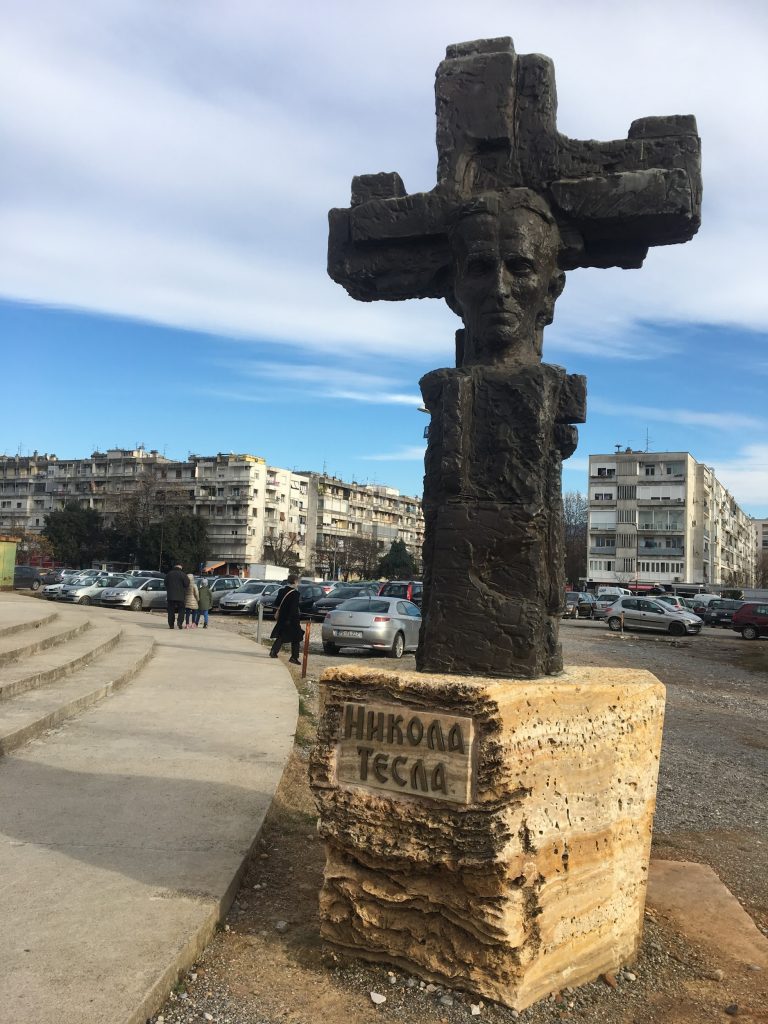
Madeleine Lewis graduated from UA in 2017 with degrees Religious Studies and Applied Mathematics. She is now teaching English and Computer Science in Montenegro with the Fulbright Program.
This past September, Elon Musk tweeted, “Finally, we will do Nikola Tesla proud by having his cars in his countries of origin!” This claim about beginnings, coupled with the fact that I have lived in what some people assert to be Tesla’s singular country of origin for over a year, sparked my curiosity as a scholar of religion.
In my adopted city— the small capital of Podgorica, Montenegro— there is a large and somewhat ornate Serbian Orthodox temple (“hram” in the local language). The hram itself is impressive: made out of beautiful white stone, with a large dome, covered in gold and frescoes on the inside. Situated immediately next to Podgorica’s hram is a bust of Nikola Tesla embedded into a kind of Cubist cross.
Perhaps this strikes you as somewhat odd. Tesla was a prolific scientist, a student (and eventual rival) of Thomas Edison, as well as the inventor of the AC electric motor. Given the frequently created juxtaposition between science and religion, it might seem strange that any religious institution makes a claim, let alone erects a monument, to a scientist such as Tesla. And in the past few years, there has been some controversy around his legacy, his resting place, and even his nationality. Many of these controversies rely on sources of authority and the rhetoric of origins to make their points, but such claims always reveal more information about the people making them than about the history itself. As scholars of religion often argue, any groups’ narratives about the past rely on their interests in the present.
Each account of Tesla’s life makes its own assumptions and exceptions. When arguing that Tesla’s cremated remains be moved from the Tesla Museum to St. Sava Hram in Belgrade, the Patriarch of the Serbian Orthodox Church publicly stated that it is natural for such an important figure’s final resting place to be the “holiest place of Serbian history”— ironically (perhaps?) overlooking the Church’s complete prohibition of cremation at the same time. Scientists in Serbia criticized this choice, starting a Facebook campaign which translates to “Leave Tesla Alone,” and the museum’s director relied on the authority of precedent as well as Tesla’s living relatives to argue that the urn should stay in place. In both cases, each group uses a narrative of authority and of the past that is informed by their present interests. Even groups from Croatia and Montenegro— Serbia’s neighbors— joined in this discourse by arguing that Tesla was not a Serb, but a Croat or a Montenegrin, each relying on their own sources and versions of history to make those points. There is no origin story that doesn’t rest on certain exclusions and presuppositions made by those in the present day.
As of October 2019, two electric car charging stations have been installed mere steps from my apartment in the center of Podgorica and Elon Musk is using his account of Tesla’s past to sell more cars in more countries; to reinforce their version of the past, the Serbian Orthodox Church has even gone so far as to embed Tesla’s head on a cross; and the Tesla Museum is still arguing that Tesla’s remains belong with them. To put it a different way, we can’t leave Tesla alone: we’re always competing with, redefining, and recreating his legacy to suit our present needs.